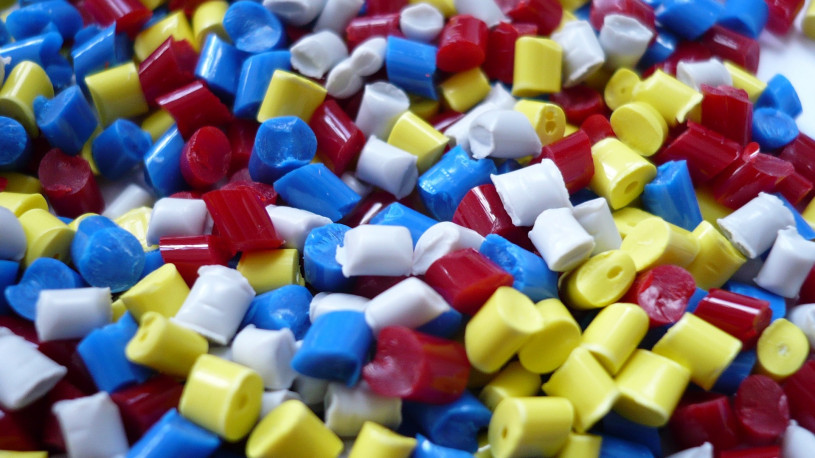-
Predictions for the Global Plastics Market to 2020
 Continue Reading
Continue ReadingThere has been much talk in recent years (including on this website) about the need for the plastics industry to go green. However, latest research indicates that whatever course of action the industry takes, in the short term at least, plastics are in the pink.
Simply put, the world needs them. Despite much of the population thinking that they are an unnecessary evil for the planet. It seems that plastics are here to stay. They are the world’s guilty pleasure.
In fact, all the indicators point to a very positive future for plastics, as developed markets seem unable to avoid using them, whilst developing markets are rushing towards consumer economies that need household goods, packaging and other consumables.
A fact that is agreed upon by all major research teams, many with some startling figures.
- 3% global plastics growth from 2013 and 2019 – Transparency Market Research.
- Global plastics market value of US$654 billion by 2020 – Grand View Research
- Global antimicrobial plastic market to grow by 10% to US$3.6 billion by 2020 – MarketsandMarkets.
- Engineering resin and polymer alloy/blend market to grow from US$38 billion to more than US$48 billion by 2020 – BCC Research.
So where is all this growth, where is the market?
Firstly, there are many new uses for plastics as they continue to replace other materials. Fifty years ago, could anyone have predicted that windows would be predominantly made of plastic, that cars would be more than 50% plastic (and how many more cars does the planet need in the coming decade?).
Who knew that plastics would be increasingly used in road and bridge construction, as well as in the pharmaceuticals industry and packaging. In fact, plastics manufacturers are already diversifying their portfolios, and are now expected to have as many as 30 products on offer by 2020, compared to today’s average of only 13.
But besides new applications, where is the money?
Primarily in Asia, where significantly Grand View Research states that the Asia Pacific region accounted for 44.6% of the global plastics market volume in 2013.
Here, not only are economies booming (increasing local demand), but exports are expanding too, as governments have created conditions favourable to investment and manufacturing. Tax benefits and financial incentives have supported the flow of foreign investment, whilst low labour costs have encouraged production to expand further. Whilst in many areas this has created overcapacity, this has merely driven prices down, further fuelling the world’s addiction to plastics.
India is also enjoying better times after a few years of business uncertainty. Now that the economy is growing in numerous sectors, the versatility of plastics means that it is set to see expansion in areas from construction to transport to packaging to consumables. Indeed, Kamal Nanavaty, president of strategy development at Reliance Industries Ltd predicts some phenomenal growth stating that, “rural income is expected to triple by 2020, to a total of US$1.8 trillion, and annual car production projected to grow from 1.7 million vehicles last year to 9.3 million by 2020.”
The Middle East is also doing well, as according to Gulf Petrochemicals and Chemicals Association (GPCA), “plastics production capacity in the Gulf Cooperation Council grew by 6% to 25.5 million tonnes in 2014 and is projected to increase by 25% to 33.8 million tonnes by 2020.”
An increase of 25% in 6 years, is truly remarkable, especially as such growth is predicted in so many areas. These include Polyethylene, where growth will be driven by increased demand for film and sheet products, injection moulding, pipe manufacture and food and beverage packaging.
Whilst Polyethylene terephthalate (PET) is expected to be the best performing segment of the market with predicted growth of 8.5% to 2020, caused in part by demand for carbonated soft drink packaging (when did you last drink Coke from a can?).
Significantly, North America and Europe, the two most mature markets are not expected to see significant growth. In fact they will both do well to avoid stagnating output in the coming years, caused by sluggish growth in home markets and increased competition from suppliers in other regions.
The best performing countries are expected to be in Central and South America. Both of these zones have low production costs, as well as good growth in industries that require plastics, such as automobiles, electronics, domestic appliances and construction. According to data from Transparency Market Research, the regions plastics industry will grow by 6.3% by 2020.
Whilst Brazil and Argentina has seen some troubling economic times of late, an increase in demand for cars in these two countries is supporting a recovery in the plastics market. Meanwhile, other South American countries all have healthy economies with places like Columbia, Chile and Peru all with plastics’ markets growing at in excess of 4%.
The Mexican petrochemicals market is also predicted to shine, increasing revenues from US$1.06 billion in 2013 to US$1.64 billion in 2020, according to consultants at Frost and Sullivan, with the biggest growth to be seen in the polybutylene terephthalate (PBT) and styrene-butadiene-styrene (SBS) markets, with respective growth rates of 11.3% and 8.7% from 2014 to 2020.
Certainly the industry does have some challenges ahead. It has a very poor public image and its production costs can be heavily dependent on the price of oil. That said, efforts are being made to find effective biodegradable plastics and to limit the amount of plastic sent to landfill. This can be seen in projects such as Plastics 2020, where European industry leaders are aiming to reduce the amount of plastics reaching landfill sites. Industry spokesmen are hopeful that 57% of plastics will be recycled by the target date of 2017.
Hopefully, initiatives like this can help the public to see a better side of the plastics, especially as it is an industry that will increasingly be supporting the world economy and offering so many new jobs in the coming years.
Whilst the global plastics industry is in a very strong position for the short to medium term. Long-term predictions are never easy, but with so many indicators and experts promising such spectacular growth, it seems that whether plastics go ‘green’ or not, the future is still very rosy.
-
The Challenges Facing Independent Chemical Traders
 Continue Reading
Continue ReadingThese are challenging times for independent chemicals traders. In fact, they are close to becoming an endangered species.
Whilst the chemicals industry, if analysts are to be believed, is due to embark on a few decades of growth as consumerism grips the developing world, the trading on the chemicals needed for that expansion is increasingly controlled by a handful of large corporations.
As economies of scale have influenced the production side of so many products, the power of money and the bargaining position that big business holds has led to the near extinction of the smaller businessman. The talented trader who could once use his networking skills and extensive contact list to make a deal is finding the margins smaller and smaller on each deal. The competition for many is too strong, and they are forced to join the corporate giant to ensure that the mortgage is paid, taking a lower position, with less pay and freedom for the sake of a guaranteed payday.
Unfortunately for the talented and self-motivated salesperson, the international conglomerate is keen to promote brand driven sales, where the company’s name, rather than the legwork of the sales rep, attracts business deals. By doing so they hope to save money (by paying lower commissions) and instead spend money on bigger, swankier offices and corporate branding, to the detriment of the smaller independent trader.
Thankfully, there is still room for expertise. A chemicals trader must still know his acetate from his acetone, as well as his REACH from his K-REACH. Plus there is the countless other trading rules and regulations, import restrictions, export duties and tariffs to consider (a situation that leads many smaller firms to focus on niche markets). Finally, there is also a minefield of logistics to factor-in, that sometimes not even the super computer ‘Deep Blue’ could fathom smoothly.
The Internet itself has become both a bane and a boon for smaller businesses in the chemicals’ trading world. It allows for the free spread of information, so that product prices in Moscow are also known, almost instantaneously, in Marrakesh. But the trader must still sift through the information, to find out what is worthy and what isn’t. In such a wealth of information the overall picture can get lost. The smaller business, if not careful, can be weighed down with over-information.
Online trading platforms meanwhile, whilst seeming to be in their second infancy (please see the earlier blog article on this topic; https://blog.spotchemi.com/will-the-way-we-trade-chemicals-ever-change/) have yet to show whether they will be a help or a hindrance to the independent trader. On the face of it, they will drive down costs, so that it is no longer necessary to be trading chemicals in a city that acts as a trading hub, as the trading floor is now a virtual one. But this benefit also supports the bigger player, whose trading overheads are much larger. The removal of these costs, places more emphasis on the power of negotiation.
In an online world, negotiation has become less of an art form, enjoyed over cocktails, and more of a science, employed over calculators.
A similar shift in how things are done, can be seen in the way that Texas Holder Poker has moved online, removing the art form of reading a players hand through his facial expressions.
But skill in online poker still remains, and if there is skill, then there is room for individual talent, determination and drive. So surely the future is bright for independent traders. Whether they decide to network, build up the Rolodex of contacts or take the route of using an online trading platform, chemicals are still needed (maybe more so than ever before) and that means that someone will be needed to buy and sell them.
-
Recycling of Rare Earths from Electronic Waste
 Continue Reading
Continue ReadingPeople who are ‘in the know’, know that incorporating rare earth elements in electronic components significantly improves their electromagnetic properties. Everybody else, doesn’t know that most household appliances, from the vacuum cleaner to the refrigerator to the many mobile phones that each home has, contain these rare earth minerals.
As their name suggests, they are rare and often difficult to extract, and so are a major goal in the recycling industry.
At present, over 95% of world production of rare earth elements is located in China. A fact that gives cause for concern in many regions, as control of rare earth mineral supply has huge strategic implications given their use not only in household objects, but also in the vital components of computers, nuclear power plants, space programs, military command and missile defence systems, nuclear submarines and the chemical industry.
The Chinese monopoly of production was completed in the last decade of the 20th century, when the United States, as the second largest producer, began to slow down production due to decreasing productivity, rising costs and for environmental reasons. This unbalanced situation lead to China setting quotas and initiating export licenses, that resulted in a trade dispute at the WTO in Geneva. The ensuing brawl and barriers triggered skyrocketing prices, that decreased Chinese exports in the early years of the milenium.
It was hoped that the dispute would have been resolved by the end of 2013, but by then the United States had chosen to renew its mining and production efforts, to bring about a desired reduction in world prices. However by this time, the whole pricing debacle had attracted the attention of scientists and investors in the search for a global strategic solution to sourcing rare earth minerals. One of the solutions found was through efficient recycling.
Until recently, there were two main recycling methods, a pyrometallurgical process which uses high temperatures for separating rare earth elements (lanthanides), and a second method which employs strong acids, and the subsequent use of selective reagents to separate lanthanides that are contained within a given source.
The first method has a very high energy bill, which given rising energy costs negatively affects the economic effeciency of recycling. The second method can have problems with the individual effect of the specific agents used, and also produces a large amount of hazardous waste.
To solve these problems, a new method has been found that is partly based on a process of separation by leaching, followed by the use of hollow fibre membranes in polypropylene that contain microscopic pores for further selection. After leaching, the prototype device uses a series of eight membrane pumps that push the solution to the outer surface of the hollow fibre membrane. At this point researchers found that by introducing an organic solvent containing an extractant, they were able to select lanthanides.
At the start, the extraction solution is immiscible with the feed solution, which the higher pressure within the membrane prevents flowing through the pores. However, since the extractant is in contact with the feed solution where it meets the pores, the lanthanides are passed through and in doing so are sepated from the solution. Subsequently, a stripping acid (oxalic acid solution) is utilised on the surface of the membrane to obtain the lanthanide solution. Researchers then precipitated a mixture of lanthanide oxides from the stripping solution, by way of filtering, drying and calcinating.
Using X-ray diffraction the substance was confirmed to be free of detectable impurities, such as iron and boron, allowing the oxides of lanthanides to be directly reused for some applications without further processing.
Research is ongoing, as the challenge still remains to find a single-step method that will allow the selection of individual element of the lanthanides. For now though, it is known that the system can recover more than 90% of the lanthanide contained in most types of waste; a figure that is comparable to other current methods.
The method is still at a prototype stage, but could generate anywhere from 20 to 30% less chemical waste than conventional extraction techniques. A fact that could have far reaching global implications, not only for the recycling and chemical industries, but for both economic and politically strategic reasons for years to come.
